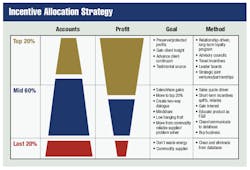7 Easy Steps to Make a Contractor Incentive Program Successful
Frankly, nobody wakes up in the morning and wants to do a contractor incentive, loyalty or spiff program. You have plenty else on your plate, and perhaps your past program administration was a hassle for you and the contractor, the rewards uninspiring and most important – you could not measure ROI!
Running a successful contractor sales program takes someone with experience and careful strategizing around communication, education, validation, reward fulfillment and how to effectively convert key performance indicators (KPIs) into measureable ROI.
Fear not, fantastic new online/mobile technology and agencies that specialize in the HVAC/plumbing industry have opened a new world of opportunity. In this article, we’ll identify some of the important steps in running a successful incentive program. Keeping these procedures in mind will help you maximize your program’s effectiveness:
- Envision your outcome: Like a good golf swing, you need to visualize what would be a successful sales incentive program in advance. Consider long-term product knowledge, relationship building and other qualitative benefits in addition to short-term sales spikes. Whatever your goals are, you should be able to determine definitively whether or not you are on track to meet them and adapt quickly if you are not!
- Rules = KISS: Make sure rules, rewards and the process are immediately understood. If it is complicated, unattainable and a hassle, the program will fail. Change the rules as you need to make the program more effective. Local markets change quickly. Make sure you have an online/mobile platform that is easy to adapt. New technology allows you to have different rules for different markets, allowing you to run many unique region-specific programs simultaneously. This is a “rifle” approach and far more effective.
- Ask contractors their opinions: The quickest way to make the “feet on the street” feel more attached to a short-term spiff or long-term loyalty program, is to routinely train and survey them via new smart phone technology or gamification. Gamification is the new hip way to get people involved and a great way to maximize your budget! Incorporating their ideas or opinions means they will be more invested in whether or not the program succeeds. Use “Learn & Earn” and/or “Spin to Win” tools to update databases, gauge product knowledge and gain competitive insights. A 2015 D&B study suggests “87% of marketing databases are functionally invalid” and our own experience with our 220+ clients collaborates that. In addition, our studies show contractors are 20x (that’s right 20 times) more likely to update data or study product features if there is an immediate reward associated with the process. It does not have to be big, but it does have to be immediate and attractive.
- Rewards must be immediate, attractive, public: Pavlov’s Theory: “The time it takes to get rewarded and the amount of reward are related. If you reduce the time of recognition, you can reduce the reward and have a greater outcome.” The new workforce demands choice and public recognition. Don’t forget Gen X and Y now makes up two-thirds of the American workforce. A cooler is not going to motivate anyone to elevate their behavior, but fear not, now your contractors can order just about any award on their smart phone. There is even same-day in-store pick up. New smartphone technology has reduced claims validation time from three months to three minutes. This is huge! Sustain high levels of motivation by running several small incentive goals or promotions between large ones. This will inject bursts of energy into the program, driving motivation and keeping them engaged.
- Communicate: Communication early and often in any and every way you can. For example, on-demand available postcards, e-mails, text and mobile app pushes should be created to the demographics of the recipient. Be thinking about two-communication, surveys, referrals and tutorials. Keep the mantra “what’s in it for them” in everything you do. Consider the incentive as an integral part of your communication schedule. Use the incentive to bring dealers to your “open house” or trade shows. Get a spokesperson. One of our clients has even hired a major football celebrity that announces, explains and encourages contractors to participate. Don’t forget to attach a promotion to a new or seasonal product. Use the promotion surgically to combat a competitor or pricing/margin issue. It is always easier to end a spiff than increase prices.
- Allocate budget (Easy as A, B, C):
- A: Thank your top 20% of contractors for their loyalty, stroke their egos, solicit their counsel and keep them away from the competitors. Don’t expect more volume because they are already giving you “mindshare” and “market share.” You need them to preserve your sales revenue. Consider this as a very pleasant form of insurance.
- B: Move the “sales needle” by incentivizing your mid 60% with “call to action” short-term incentives, spiffs rebates and training “Learn & Earn” promotions. This is the group that has upside potential. Could be a competitor’s top 20% that you want to pursue. Use the incentive to enhance your marketing database. Buy business if you have to.
- C: Forget the bottom 20%. They will never be worth your trouble. Above (see chart) is an “infographic” that highlights a good strategy.
- Plan, measure, adapt, repeat: Now that your dealer/contractor incentive program is in place via your online/mobile marketing platform and you know what you want to achieve before, during, and after the program termination, you need to concentrate on how you can continue the momentum. Research shows that even shortterm spiffs have a lasting beneficial effect of creating commonality and habits. My advice…why would you stop? Granted the promotion should have an end date, but the goodwill you have gained should live on through additional communications and promotions. Wallis Simpson, the Duchess of Windsor, was famous for her quote, “You can never be too rich or thin.” I maintain, “You can never have too much client engagement.”
Steve Damerow is CEO of Incentive Solutions, www.incentivesolutions.com. He is a recognized expert, published author and host of the national radio show “Business Matters.” Incentive Solutions currently manages hundreds of incentive loyalty programs within the building/HVAC industries. He can be reached at [email protected].


